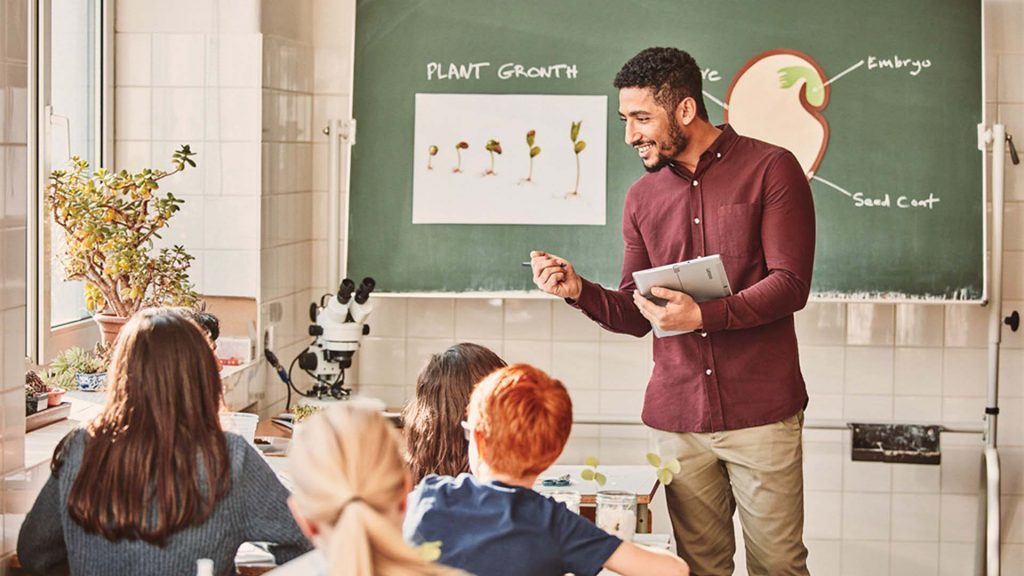
Microsoft launches Transforming Education
Supports schools preparing students for sustained success
SYDNEY – June 5, 2018 – Microsoft is today releasing the landmark Transforming Education book, built on almost three decades of research, evidence and experience. The book delivers important and practical guidance for schools which want to ensure optimal learning outcomes for all students.
Intended as a highly pragmatic playbook for schools and school communities, the book explains the critical importance of digital transformation to students’ sustained success; details the programs of work needed to transform a school; outlines the skills that students will need to succeed on graduation; and provides practical templates and guides that schools and school communities can use to get started.
Transforming Education’s executive editor, Anthony Salcito, Vice President of Worldwide Education, Microsoft, who is in Australia to speak at leading education conference Edutech, said: “The entire purpose of this book is to empower schools to ensure that the students of today can create the world of tomorrow.
“At Microsoft we believe we can provide valuable insight and guidance on how schools can turbo charge their innovation and transformation efforts. The book provides a roadmap for schools and school communities which want to ensure that students are equipped with 21st Century competencies that will prime them for success and pique their appetite for lifelong learning.”
As workplace automation gathers pace and artificial intelligence starts to augment individuals’ capabilities, tomorrow’s successful workers will require strong literacy and numeracy skills, STEM (science, technology, education and maths) understanding, and a demonstrated facility for collaboration, communication and creativity.
Transforming Education resonates with the David Gonski-led, Review to Achieve Educational Excellence in Australian Schools which was released in May. That review notes that; “By the end of schooling, every Australian child needs to emerge as a connected and engaged learner, prepared to succeed in and contribute to a rapidly changing world. This means students must have acquired the basic building blocks of learning, in particular literacy and numeracy skills. They must also have a range of skills providing the job resilience required to be able to adapt and respond to fast-shifting education and workforce needs.”
The report however notes that in 2015, Australian 15-year-olds scored significantly lower than 15-year-olds in 2003 when faced with equivalent testing.
“There are 3.8 million students in Australian schools today. We owe it to them and to future generations to arrest this slide. And now we have the blueprint for how to do that,” said Salcito.
Transforming Education’s evidence base reinforces the Gonski Review’s recommendation for on ongoing assessment to ensure each student reaches their full potential and explains the powerful role that analytics plays in optimising learning outcomes.
At present the Review suggests that each year’s most advanced students can be as much as 5-6 years ahead of their least advanced peers and calls for a transformation of education so that each student is able to achieve at least one year’s growth in learning for every year they attend schools.
Continuous assessment and tailored learning intervention based on evidence-based best practice is the most effective way to achieve that desired outcome.
While schools and teachers have continually sought to improve their learning impact, there is evidence of a disconnect between technology, process (including teachers’ professional development), pedagogy and curriculum which Transforming Education seeks to help bridge.
Acknowledging that change can be challenging, the book provides deeply practical advice to help schools and school communities get started, flagging the challenges and opportunities that need to be either navigated or embraced.
It steers school leaders and school communities through:
· Phasing your Transformation
· Digital Transformation Journey Map for Institutions
· Checklist: Choosing Student Devices
· Checklist: Choosing Devices for Deep Learning
· Keeping Your Child Safe Online: Parental policy guidelines
· Sample Internet Acceptable Use Policy: Staying safe online guidelines for students
· The Language of School Transformation: Positive ways to talk about change
· The Language of School Transformation: Positive ways to counteract negativity
· Assistive Technology for Vision Impairment
· Assistive Technology for Hearing Impairment
· Assistive Technology for Mobility/Dexterity Impairment
· Assistive Technology for Learning Impairment
This section of the book provides sample conversations to help engage school communities in transformation initiatives; it sets out the questions school leaders need to ask themselves and their teaching staff about how to get started and what to prioritise; delivers practical advice about how to incorporate higher order thinking skills into lessons; and features decision trees to help teachers assess how well their students are progressing.
This groundwork allows schools to develop a clear understanding of what they want to achieve and understand how richly featured computers which promote collaboration and allow students to use both keyboards and digital pens have been proven to have most learning impact. It also details how specially designed interfaces and tailored learning solution can support students with special needs.
About Microsoft
Microsoft (Nasdaq “MSFT” @microsoft) enables digital transformation for the era of an intelligent cloud and an intelligent edge. Its mission is to empower every person and every organisation on the planet to achieve more.
For media enquiries, please contact:
Rudolf Wagenaar, Commercial Communications Lead, Microsoft Australia
Email: [email protected]
Mobile: 043 908 2550
















